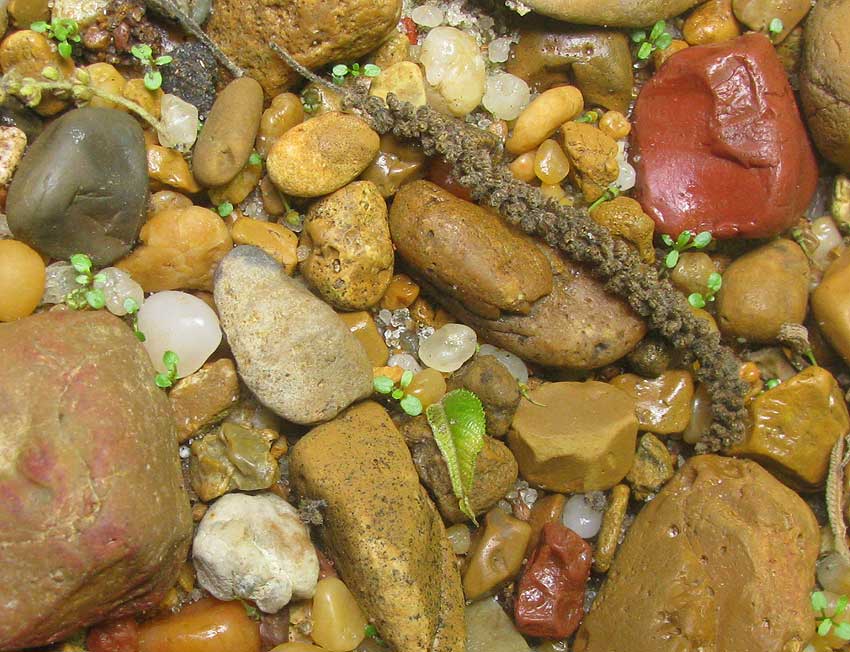Excerpts from Jim Conrad's
Naturalist Newsletter

from the May 6, 2012 Newsletter issued from the woods of the Loess Hill Region a few miles east of Natchez, Mississippi, USA
TWO WAYS TO THINK ABOUT GRAVEL
Stream bottoms here are sandy with occasional deposits of gravel. The gravel is fascinating stuff. Sometimes I lie with my face only an inch or two from it, exploring every pebble, trying to understand what's before me. A sample of what I saw the last time I did this is shown above.
Looking into gravel, the mind has two main paths to take. The first path is to identify what's there. That helps us know what's normal, and what's special. Taking the first path with the above image, the first thing I notice is that all the pebbles are rounded. Therefore, they've come a long way -- maybe hundreds or even thousands of miles -- rolling and tumbling in running water, having their corners knocked off, becoming more and more spherical and smooth.
Something else to notice is that they're all silicates -- all composed of atoms of silicon and oxygen, the two most common elements of which the Earth's crust is composed. Silicon provides about 28% of the Earth's crust by weight, and oxygen some 47%. However, the pebbles contain different amounts of other elements, too, so they display different colors, different textures and densities.
Most of the pebbles -- the yellow-brown ones -- are chert. Highway engineers might call this chert gravel. The reddish pebble at the picture's upper, right corner is chert containing much more iron oxide than the other pebbles, so it's known as jasper. This is low-grade jasper. Finer-textured jasper rocks are considered semiprecious gemstones and can be polished to be made very pretty. The white pebbles are more purely silicon dioxide. The brightest white pebbles showing translucency and very fine texture are the purest quartz, but they still contain too many impurities to be crystalline. The pure white ones are sometimes called white quartz. Tiny, transparent sandgrains are crystalline quartz -- pure silicon dioxide, SiO2.
The second train of thought gravel sets our minds on begins with the question, "Where does this gravel come from?"
Gravel here in southwestern Mississippi derives from two main sources. Gravel in the Mississippi River lowlands was deposited during the various Ice Ages (of which there were three main ones) during the Pleistocene Epoch from about 10,000 years ago to some 1.7 million years ago. This Ice-Age gravel originated hundreds of miles to the north where glaciers ground up the bedrock they passed over, carried the shattered stone along, and ultimately released it in torrents of meltwater that rushed southward in white-water streams to our area and beyond.
Our other gravel -- the one in the picture -- occurs just beneath the loess of our loess-mantled uplands. It's primarily of Pliocene age, deposited 1.7 to 5.3 million years ago. At that time the southern half of what is now the state of Mississippi was a broad alluvial plain covered with south-running "braided streams." Water in the streams brought our gravel from the north where forces within the Earth were causing the land to rise in three main places -- the Ozark region, the southern Appalachians, and central Tennessee. Our gravel came mostly from atop a "dome" that formed at that time in central Tennessee -- a dome that now has eroded into a structural basin.
If you live in a different part of the world and you have gravel, of course the story of where your gravel comes from will be different, but just as interesting. With fancy search-engine work, maybe you can discover its origin, and what's special about, and start feeling the same buzz I feel when visiting my own gravel deposits.